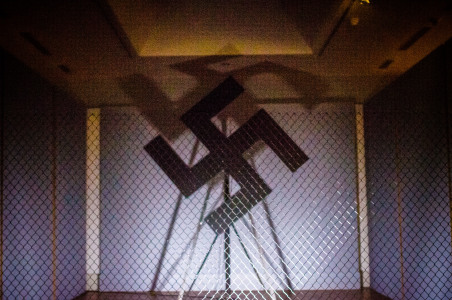
“It seemed like the apocalypse was upon us.” This is the mindset of nuclear anxiety to which John Scott attributed his art, which is currently on display in the Faulconer Gallery. The show, “Dark Commander,” is the first U.S. exhibition by the acclaimed Canadian artist, which takes the form of a multimedia post-apocalyptic vision of fascism and nuclear disaster.
His assembled works are striking in both scale and content and feature a diverse array of mediums, including a cloth tent, a motorcycle and a massive spinning metal swastika. The show also includes many of Scott’s two-dimensional works, which paper the walls of the gallery, unframed and overlapping, in an approximate replication of Scott’s own workspace, conjuring a sense of intimacy despite the intimidating scale of the images. These pieces consist primarily of oil stick on paper and feature dark figures alongside annotations by the artist which offer insight into the political weight of Scott’s deceptively simple work.
Scott, who has held a longtime aspiration to write science fiction, said that much of his work was inspired by “the possibility of a large scale nuclear war. Man’s survival seemed the most pertinent question to deal with.”
Among the pieces that have provoked strong reactions is “Europe,” a metal swastika attached to a large fan which spins behind a chain-link fence, illuminated by a strobe light which makes the swastika’s silhouette appear intermittently before restoring the fan and its viewers to darkness. Scott said the piece was inspired by his encounters with casual anti-Semitism in Europe.
“I wanted to represent the hidden specter of fascism that was in North America and Europe,” Scott said. “Just because people aren’t wearing swastikas doesn’t mean they’re not fascist.”
Multiple interpretations of this piece were expressed in a panel discussion last Thursday, Oct. 30, entitled “Who Owns the Symbol?” which explored the shifting meanings the swastika has accrued through history. Daniel Strong, the exhibit’s curator and Faulconer Gallery Associate Director, appreciates that the piece forces its viewers to confront difficult content.
“If we can’t talk about symbols … how can we ever take apart our immediate reactions and see what lies beneath?” Strong questioned.
Panelists voiced concerns that the piece was an attempt to aestheticize a symbol of oppression which is ultimately inseparable from its violent past.
“We don’t own the symbol so much as it owns us,” said Professor Dan Reynolds, German.
But the subject matter of Scott’s work is not limited to warfare. His piece “Bunny Boudoir” features a cloth tent painted with the repeating icon of a rabbit’s head painted across its walls and over the chair, vanity and mirror housed within the tent. The work also features the gown Scott donned as part of a drag performance he enacted in the 1980s, adopting the persona of “Diane Frankenstein” to underscore the constructed nature of identity. Strong said that this is only one example of Scott’s interrogation of gender, which is uniquely informed by his experience as a person with disabilities. Strong read Scott’s works as critique of conventional masculinity.
“What I’ve also come to see in his work is not just the warrior archetype but also the masculinity and the male archetype in general, and he’s coming to it from the perspective of a man who’s been in a broken body his whole life … so he really comes at the idea of masculinity and masculine archetypes as somebody who could never meet them because his body never met any kind of masculine ideal. And so that is what I see as the core of his work.”
Ultimately, Strong said, the challenging nature of Scott’s work is vital for its ability to catalyze thoughtful reactions in its viewers and is uniquely relevant to audiences today.
“It’s a difficult subject to conquer, and [at the] centennial of World War One, these are things we need to be thinking about,” Strong said. “People might want to come into an art gallery and forget all that but sorry, I can’t do that, not in this exhibition. It is an exhibition that’s going to provoke an emotional response.”


































































